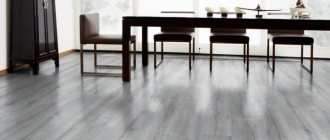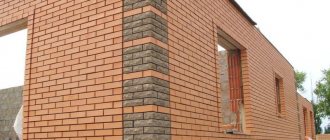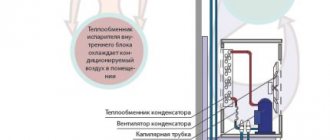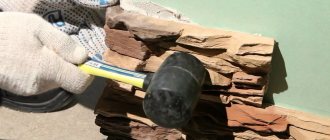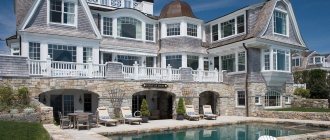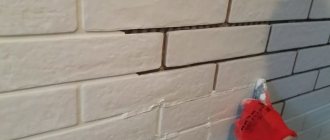In modern house construction, various materials are used to construct walls, which do not always look aesthetically pleasing. Houses can be slag-filled, panel, frame, made of monolithic foam concrete, built from blocks. The appearance of such houses requires facing work, for which facing bricks are often used, having both standard and non-standard sizes approved by GOST. A facing brick can be single, one-and-a-half or double, solid or hollow, and its size and weight will depend entirely on its characteristics. The walls of houses lined with this finishing material give buildings a beautiful appearance, increase the thickness of the walls and make the building warmer.
Facing bricks are used for decorative purposes.
For lovers of classic walls, red ceramic bricks are offered for cladding, having standard, identical dimensions for all products, approved by GOST.
Decorative types of cladding can be used to decorate walls to imitate natural stone. To do this, choose modern sand-lime bricks, which are produced in various colors. Often, facing silicate has a special type of texture that imitates crushed natural stone. A house decorated with this type of cladding amazes with its unexpectedly magnificent appearance.
Properties of facing bricks.
Manufacturers may offer a standard white silicate intended for finishing. For lovers of colored walls, smooth hollow silicate bricks painted in various colors with iron oxide are offered. The dye used in silicate products is so durable that they do not lose their color when exposed to sunlight, even over time.
The brick will retain its original shade for a long time and delight with its beauty. The ideal lines and internal cavities of the hollow, lightweight, and decorative bricks help create a finish that looks flawless on the outside. Each type offered by the manufacturer has its own positive unique properties that you need to be able to take advantage of.
Fireclay brick parameters
For the construction of stoves and fireplaces in the area of contact with fire, special fire-resistant bricks are used. In its production, a special type of clay is used - fireclay. That’s why such a brick is also called fireclay. The production process is the same as for building red bricks - molding, drying, firing in a kiln. But, due to the special properties of fireclay, the resulting building material can easily withstand prolonged contact with open fire. There are two brands of general-purpose refractory bricks used in everyday life: ShA and ShB. ShA can withstand temperatures up to 1690°C, ShB - up to 1650°C, all other parameters are identical. Therefore, their scope of application is the same - this is the molding of fireboxes for fireplaces and stoves.
Some types of fire bricks: sizes may vary, but they are all standardized
Encode the size of the refractory brick in the number that appears after the abbreviation:
- ШБ-5, ША 5 - 230*114*65 mm;
- ShB-6, ShA 6, ShA 14 - 230*114*40 mm (flying blade);
- ШБ-8, ША 8 - 250*125*65 mm;
- ШБ-9, ША 9 - 300*150-65 mm;
Most often they use ShA 8 or ShB 8. They are the same in length and thickness as the ceramic red brick from which the rest of the stove is made. There is also a wedge-shaped refractory brick - for forming firebox arches and smooth curves in the horizontal plane.
There are two types of wedge refractory bricks:
- end - for forming curves in the horizontal plane ША, ШБ 22 - 230 * 114 * 65/55 mm;
- ША, ШБ 23 - 230*114*65/45 mm;
- ША, ШБ 48 - 250*124*65/45 mm;
Types of wedge fireclay bricks: edge and end wedge
- ША, ШБ 44 - 230*114*65/55 mm;
These are not all the sizes and types of fireclay bricks. You will find more in GOST 8691-73.
Colors, textures and shapes
Clinker and ceramic facing bricks have a varied color palette. To obtain a textured design on such products, it will be enough to apply it to raw clay and send it to the oven for firing.
Manufacturers also use other technologies for applying decorative elements:
- Engobing (after firing, a glassy film is formed on the product);
- Glazing (a thicker and more durable film is formed than with engobing);
- Shotcrete (mineral chips are applied to the surface).
The shapes of the products are also different: corners, curls, spheres. You can find materials of bizarre shapes and diversify the façade masonry. Each home owner will choose a facing brick option to suit his taste and budget. When choosing a material, pay attention to the quality of the product, its size and shape. The parameters of the selected brick must comply with GOST; if there is the slightest deviation from it, it is better to choose another option.
Types of bricks
In addition to finishing the house, facing bricks are used in the construction of pillars and columns of fences, fences in gardens and parks, in the design of gazebos, arches and small architectural forms. Any material has standardized forms, but it must have two sides with a decorative surface - a spoon and a poke. This is the “face” of the material.
There are several types of this building material:
- Ceramic - can be hollow or solid. The latter option accordingly has more weight, which should be taken into account when calculating the load on the foundation.
- Clinker - has a dense structure, which ensures moisture resistance and frost resistance.
- Hyper-pressed - made of clay and sand, in cross-section it has an expressive chip, similar to natural stone.
- Silicate - used less frequently due to its low decorative qualities. However, it has a low price.
Ceramic facing brick
Ceramic bricks are made from special brick clay that is first formed and then fired. This facing material is considered one of the environmentally friendly and safe materials in construction, which does not emit any impurities. Ceramics does not absorb moisture and is able to “breathe”.
Ceramic option
In addition, the facing brick has a standard shape and uniform color. There are no splits or cracks on the surface of the material.
Standard material sizes are: 25/12/6.5. The weight of the product ranges from 2.7 to 6 kg depending on the size (single, double).
Clinker brick
Clinker facing bricks are made from special clay, from which the product is formed and fired in a kiln at a temperature of 1200 ֯C. The product is very durable due to the strong adhesion of clay particles. Color difference may occur due to pigmentation. In order to prevent strong differences in the shades of the material during production, manufacturers use a standard formula. This facing material can be dense or with internal cavities.
Clinker
Paths and terraces are made from this material.
Installation of this brick is a labor-intensive process that requires the participation of specialists. You should not install clinker bricks in hot weather when the original wall gets very hot. The moisture will have time to dry before it has time to penetrate into the structure of the product. Standard dimensions of the base brick are 240/115/71 mm. Weight can range from 1.6 to 6 kg, depending on size.
Hyperpressed brick
Hyper-pressed facing bricks are produced by semi-dry hyper-pressing from materials of natural origin (limestone, shell rock). Sometimes mechanical chipping technology is used. The result is a material with an unusual relief - during the manufacturing process, dyes are added to the source material, which make it possible to obtain a material with a wide color spectrum. This material is often used for cladding the facades of not only one-story, but also multi-story buildings.
Hyper-pressed
However, this material has many disadvantages and manufacturers rarely mention them, which is unfair. After all, when selecting the optimal material for cladding the facade of a house, the applicant expects to receive comprehensive information about all the technological characteristics of the material.
The dimensions of the standard material are 250/120/65 mm and the weight is 4.5 kg.
Sand-lime brick
The composition of the silicate facing material is limestone and sand, which are held together with water. If the proportion is violated, this can lead to low-quality products, so manufacturers carefully control the process at all stages. To give the material strength and density, it is pressed.
Silicate
Facing sand-lime brick has high geometric accuracy. It is manufactured in accordance with accepted standards, due to which it has clear corners and a smooth surface. This material is frost-resistant and can freeze and defrost several dozen times without loss of quality.
The size depends on the type of brick. Standard size – 250/120/65 mm. Weight varies from 2.5 to 6 kg.
Which cladding is better
When choosing facing bricks, you should take into account not only the dimensions, but also the scope of application of the products, their practical characteristics and workability
Despite the physical and mechanical diversity of products, technical characteristics must remain at a high level. Therefore, when determining the material for finishing buildings, you should rely on the qualities shown earlier. By sorting by type, you can determine the best indicators:
- Frost resistance, strength, and resistance to water will be better with clinker bricks, followed by hyper-pressed ceramics. Silicates come in last place.
- Thermal conductivity is better in ceramics, then clinkers, and then silicates and hyper-pressed materials.
- The weight load on the foundation is the least for ceramic bricks; as for hyper-pressed bricks, this is a heavy material and can only be used if there is a very strong foundation for the building.
When choosing facing bricks, it is worth considering not only the dimensions, but also the scope of application of the products, their practical characteristics and workability. For example, large-format non-standard bricks will allow you to cope with the cladding faster, but yellow finishing material with a width of 85 mm guarantees the aesthetics and thoroughness of the work performed. In addition, the price of the batches matters, but it all depends on the preferences and wishes of the customer.
Clinker decorative facing brick: dimensions and characteristics
Clinker brick is in many ways similar to ceramic brick. But there are certain differences between them related to the characteristics of the raw materials and temperature conditions for firing. In order to make clinker bricks, predominantly medium-melting and refractory clays are used, so that firing, accordingly, requires higher temperatures.
Decorative facing bricks can be combined in texture and color, obtaining a unique appearance of the facade
The result of using this technology is a more durable facing brick, which is characterized by a minimal level of water absorption and excellent resistance to all kinds of external factors. Such characteristics allow it to be used not only for decorating the walls of a house, but also as a facing material for foundation plinths, paving paths and erecting fences.
But there are also indicators in which clinker brick is inferior to ceramic brick. For example, this concerns thermal conductivity, which in this case is slightly higher. True, this disadvantage is compensated by the fact that the material is characterized by a high level of resistance to cracking as a result of exposure to low temperatures.
The colors and textures of clinker bricks can be so diverse that you can even come across the concept of “collections” that various manufacturers offer their customers. As for the sizes of clinker bricks, here you can find a wide variety of options.
The standard size of decorative brick can have the following parameters - 250x120x65 mm, 250x90x65 mm and 250x60x65 mm. As you can see, the height of the brick can change, but the length and width of the brick remain unchanged. The only exception is the elongated elements, the parameters of which are 528x108x37 mm.
Dimensions of facing bricks
Using lightweight bricks when laying walls
The use of lightweight bricks when laying walls of low-rise structures, or when constructing the upper floors of multi-story buildings has become widespread. Lightweight bricks cannot be used in the construction of foundations, plinths, walls in contact with the ground, chimneys and ducts, and furnaces. Also, this type of brick cannot be used for laying walls in rooms with high humidity, because under its influence it will collapse.
Our company sells lightweight fireclay refractory bricks, intended for the internal lining of stoves, fireplaces, chimneys and chimneys, as well as for the construction of the upper floors of buildings.
We produce and sell fireclay bricks and various refractories for industrial and private construction.
Classification of facing bricks
The gradation of façade cladding is determined by its manufacturing technology.
There are four categories of facing bricks:
- Ceramic.
- Clinker.
- Hyper-pressed (concrete).
- Silicate.
Brick in each of the listed categories is available in two versions: solid and hollow. The weight of hollow core brick is on average 25-35% less, and its resistance to heat loss is approximately 10-15% higher.
Ceramic facing brick
It is produced by firing a raw material mixture consisting of red fusible clay, organic and mineral additives that regulate plasticity. Coal dust, slag, fireclay, sawdust, ash and quartz sand are used in this capacity. The initial mixture successively goes through the processes of molding, drying and firing. The main difference between facing ceramic bricks and ordinary ones is the careful preparation of the components before molding. Therefore, there are no foreign inclusions or cracks in it.
The material obtained at the exit from the firing chamber is resistant to moisture, high strength and good energy-saving qualities. The types and colors of ceramic facing bricks are varied.
On sale you can find not only ordinary, but also shaped material (for laying complex architectural elements). To expand the color range, manufacturers use mineral dyes (chromium oxide, finely ground iron or manganese ore), adding them to the composition of the feedstock.
Decorating the surface of ceramic bricks is done in several ways. In addition to the smooth matte and shiny surface, finishing options are available that give this material a resemblance to wild stone.
Clinker brick
The closest “relative” of ceramic brick. The main difference between them is the raw materials and firing temperature. Medium and refractory clays are used to produce clinker. Accordingly, they are fired at a higher temperature. The result is a very dense and durable facing brick with minimal water absorption. These qualities make it possible to use it not only in facade decoration, but also for cladding the base of the foundation, building fences and paving paths.
The thermal conductivity of clinker stone is higher than that of ceramic stone. This disadvantage is compensated by its high resistance to cracking under the influence of low temperatures.
The color palette and texture of clinker stone are extremely diverse, since each manufacturer offers customers its own collections. The size range of this cladding also cannot be called boring. In addition to the standard single version 250x120x65 mm, you can buy bricks of reduced thickness and height, as well as long clinker (528x108x37 mm).
Hyperpressed brick
Firing clay is an energy-intensive process and not very profitable. Therefore, many manufacturers are switching to pressed unfired bricks. Its basis is granite screenings, water and cement. At its core, it is super-dense concrete, which has been shaped into masonry bricks.
The main requirement for façade finishing is resistance to weathering. According to this indicator, hyper-pressed brick is perfect for finishing external walls.
In terms of strength and other quality characteristics, it is practically not inferior to clinker. Thanks to the texture of the surface (rock, torn stone) and the use of persistent dyes, this material looks excellent in masonry.
Finishing the facade with hyper-pressed brick looks elegant, solid and reliable
Sand-lime brick
Belongs to the category of non-firing materials. It differs from hyperpressed brick in its raw material composition. There is no cement in it. High mechanical strength is achieved here by hardening a mixture of silicate sand and slaked lime in an autoclave (high temperature and pressure).
Nowadays, silicate facade brick as a facing material is losing its former popularity. In the struggle for buyers, manufacturers have developed several color options for the silicate mixture. Unfortunately, they all look rather pale and cannot compete with the rich colors of ceramics and clinker.
This material behaves well in building cladding. Compared to clinker bricks, they absorb moisture more strongly, but at the same time, they can withstand repeated soaking, freezing and thawing better than ceramics.
Figured (shaped) brick
Today, no one is satisfied with the straight lines of the facade, so each type of facing brick is complemented by a wide range of shaped elements. Using them, you can lay out complex architectural elements without laborious hewing and cutting, dressing your house in a beautiful “stone lace”.
Product Description
Light bricks have:
- simple production technology;
- resistance to aggressive chemicals;
- high mechanical strength and heat resistance.
Light weight allows the overall size and weight of the units to be reduced, reducing labor costs for installation and specialist labor costs. Insulating brick, used for lining fireplaces and furnaces, reduces the heating time of heating units, which allows you to save on fuel. They do not contain toxic substances that are released when heated. A variety of sizes allow you to veneer any shape without trimming or adjusting.
Standard sizes
The main point of standardization of brick sizes are the following proportions: 1: 1/2: 1/4. This aspect ratio is optimal for its laying with rotation of transverse and longitudinal placement. In individual construction, single brick is in demand; its consumption per 1 m³ of masonry is 513 pieces.
According to state standards available in the Russian Federation, the size of a standard single product is equal to:
- 25 centimeters in length;
- 12 centimeters in width;
- 6.5 centimeters in height.
In addition to single bricks, the building materials market also offers other types of standard sizes:
- one and a half;
- double.
One and a half building materials began to be produced during the industrialization of the country in order to speed up the pace of construction. The standard brick consumption is 318 pieces per 1 m³. A characteristic indicator of a one-and-a-half product is the added height; GOST defines the following standard parameters of the product:
- 25 centimeters in length;
- 12 centimeters in width;
- 8.8 centimeters in height.
The double brick, having the same 25 centimeters in length and 12 centimeters in width, has a height of 13.8 centimeters. Due to its considerable size, to reduce the weight of the product, double bricks are usually made hollow. He is widely practiced in various fields of construction. Products with added height are used for the construction of both civil and industrial facilities.
Other characteristics
Impurities affect the properties of clayey sedimentary rock. Thus, with an increase in silicate content, the binding property of clays decreases and the porosity of the burned products increases, and the strength becomes less. Iron compounds at a high melting point reduce the fire resistance of clay. The salt of carbonic acid and calcium reduces thermal stability and sintering duration, increases compression during firing and porosity, resulting in reduced strength and frost resistance. Sodium and potassium oxides lower the temperature conditions for alumina sintering.
According to the intended purpose, building materials are classified as follows:
- facing - textured and shaped;
- fireclay or stove;
- for creating wall coverings.
Lightweight brick is presented in the following forms:
- end;
- wedge;
- hanging;
- trapezoidal;
- shaped.
Regardless of the configuration, lightweight brick has the correct texture, smooth edges and right angles. Depending on the filling, they are distinguished between solid and hollow.
How many bricks are in a pallet of red bricks?
First of all, you need to understand the container. Brick products are supplied on pallets of two standard sizes:
- 0.52x1.03 m - small pallet;
- 0.77x1.03 m - large pallet.
With the weight of one red brick being 3.6 kg according to the table above, the maximum weight of a cubic meter of brick is 1847 kg, the total number of bricks per square meter is 513 pieces. How much does a pallet of red brick weigh? The large pallet holds 1440 kg. And if you are wondering how many pieces of red brick are in a pallet, then this figure is 400-420 pieces. The total quantity on the pallet depends on the manufacturer and may vary up or down.
The amount of hollow is also calculated. For example, to find out how much red brick is in 1 m3, you should divide the cube by the volume of one brick or use the tabular average value.
Piece counting can be done using mathematical methods. To do this, just count the number of pieces in a row and the number of rows.
Layout of products on a pallet
Video: determining the weight of the pallet:
Watch this video on YouTube
Composition and properties of fireclay building materials
An absolutely reliable substance used for the construction of high-temperature structures is fireclay refractory clay. It has excellent thermal insulation characteristics. Only from it can a lightweight and at the same time durable briquette be made, from which the stove maker will build a safe stove. In addition to fireclay clay, sawdust or peat are added to the solution. When burned, they leave sealed pores filled with air. Thanks to this, lightweight fireclay bricks are obtained. Air is also an excellent heat insulator.
Manufacturers produce two types of refractory bricks - ShL and ShTL, the abbreviations mean:
Parameters of refractory bricks.
- Ш - fireclay material;
- L - lightweight;
- T - talc has been added to the structure of the mixture.
Digital designations provide information about the apparent density of the product. When characterizing porous products, the concepts of true and apparent density are used.
In the first option, the volume of voids is not taken into account; in the second, the ratio of the mass of the brick and its total volume with voids is taken. The lower the apparent density of a light brick, the lower its mass and thermal conductivity. But the positive thermal insulation qualities conflict with the reliability and strength of the structure, so the elasticity gradient and, accordingly, the service life are reduced.
The lightest brick of the ShL-0.4 brand has an apparent density of 0.4 kg/cm³ and a mass of 0.7 kg. It is used for the construction of furnace fireboxes with operating temperatures up to 1150°C. Fireclay bricks ShL-1.0 and ShL-1.3 have a mass of 1.7-2.2 and 2.0-2.6 kg, respectively. The spread depends on the size of the product. Operating temperature - up to 1300°C. In accordance with construction standards, the brand is indicated on each individual brick, without exception.
How to determine the amount of facing bricks in 1 m2 of masonry
The construction of any building begins with drawing up an estimate of the building materials that will be required for the implementation of a specific project.
The consumption of facing bricks required to form walls depends on the linear dimensions of the brick blocks, the thickness of the cement mixture seam, as well as the height of the walls and the method of laying briquettes.
It is unlikely that it will be possible to determine the number of blocks with the accuracy of a brick, but it is quite possible to calculate the approximate number of pieces per 1 m2.
Why exactly the consumption of blocks in m2 is calculated? The answer is very simple and lies literally on the surface: this parameter allows you to understand how many briquettes will be required for the construction of any building, even the most complex architecture.
Features of counting the number of bricks
To correctly calculate the consumption of bricks, you need to perform the following steps:
- Decide on the thickness of the masonry. The walls are formed in half a brick, which is 120 mm, a whole brick, the length of which is 250 mm, one and a half briquettes - 380 mm, two blocks - 510 mm, and also 640 mm, which is equivalent to two and a half clinkers. The warmer the climate in the location of the building being erected, the thinner the walls can be made. For middle latitudes, a masonry of 2.5 bricks is considered ideal. Also, the thickness of the walls is directly influenced by the number of floors of the building being erected, the type of arches used, as well as the type and depth of the foundation. The higher the structure, the greater the load the walls will have to withstand, so for multi-story buildings they make masonry with 2 or more bricks.
- Select blocks for masonry. To understand how many facing bricks are needed to form 1 m2 of wall, you need to know exactly the dimensions of the purchased briquettes. Bricks are produced in single size (250×120×65 mm), one-and-a-half (250×120×88 mm) and double (250×120×138 mm) formats.
- Increase the dimensions of the brick spoon and butt by the thickness of the seam. As a rule, the cement mixture is laid out in a layer of 10 mm on horizontal surfaces, and 12 mm on vertical surfaces. Since two building blocks are in contact with the seam, to take into account the thickness of the seam, when calculating the number of bricks in 1 m2 of the wall, half the value of the seam is taken, i.e., the length of the spoon is increased by 6 mm, and the height of the butt by 5 mm. Based on these data, the area of the spoon is calculated.
- Then 1m2 is divided by the area of the converted brick spoon. The resulting value is the approximate number of facing bricks that will be used to form each m2 of a wall half a block thick.
- We divide the thickness of the walls by the recalculated width of the brick butt and obtain the coefficient by which it is necessary to increase the previously obtained number of bricks.
There are several methods for laying building blocks, but all of them are used to give the facade of a building a certain aesthetic appearance and have virtually no effect on the amount of brick per m2 of wall.
The exception is patterns that are specially formed from bricks during the construction of external walls of buildings.
In any case, it is the dimensions of the briquettes used that are the key parameter that determines the consumption of materials during construction work.
Laying technology
Despite the fact that laying Lego bricks does not require any special skills or tools, there are several rules and recommendations, compliance with which will allow you to achieve high quality laying and strength of the building.
As with any other laying, special attention should be paid to laying the first row. Since mistakes made at this stage will inevitably affect the quality of the entire building, laying the first row must be done with special attention, controlling the location of each block using a building level. Particular attention should be paid to dressing the corners.
When laying Lego bricks, it is not cement mortar that is used as a binding component, but a special glue, which can be purchased at a construction supermarket. To increase the rigidity of the masonry, reinforcing rods are installed in the cylindrical holes.
Instead of applying an adhesive composition, you can fill the through cavities with concrete. This method significantly increases the strength and rigidity of the structure, but reduces the heat and sound insulation characteristics of the material. In addition, when filling cavities with concrete, the possibility of laying communications is eliminated.
To increase the rigidity of the structure, every 3-4 rows the masonry is reinforced with metal wire.
You can increase the thermal insulation properties of walls by laying Lego bricks in two rows, leaving a gap of 15–20 mm between them, which is subsequently filled with expanded clay or mineral insulation. This masonry method can significantly increase the heat and sound insulation of a building.
Following these simple rules will allow you to independently build a durable and comfortable house at minimal cost.
Which brick is better? 10 tips for choosing bricks
A dacha, a cottage, internal partitions, a foundation, a chimney, a stove - all this can be built from brick. This material has already become traditional and, despite the presence of alternatives, continues to be popular. Accordingly, many are faced with the question - which brick is better? We will share a few simple rules that will help you choose a really good brick.
Let's find out the main types of bricks
There are different types of brick, and all of them are quite good. It’s just that each type needs to be used wisely, taking into account the pros and cons.
Lego brick: what kind of material?
The new Lego brick differs from the classic building material by the presence of technological holes on the bottom side and protruding spikes on the top. Due to these grooves and protrusions, the brick looks like a children's Lego set, hence the name. The unusual configuration of the brick makes it easy to work with. It simply folds up in the same way as the children's construction set of the same name.
They came up with a brick with mutual interlocking in the form of a castle in Denmark. The main task was to create a block that would be installed simply, without complex installation technologies. Even a novice builder can handle masonry. All that is needed is to connect the protrusions of the upper brick with the grooves of the lower one. The blocks stick together well. They are fixed using special construction adhesive. As a result, the masonry resembles the assembly of a Lego constructor.
How is it made?
Lego bricks are made from cement and limestone. Various industrial wastes are also added to the composition: dolomites, shell rocks, travertines and more. In the process of making blocks, firing is not used. Thanks to this, the cost of such building materials is quite affordable. 500 bricks require about 220 kg of cement and 1.6 tons of screenings.
The blocks are produced by pressing. Thanks to strong pressing and drying, they become ultra-strong and without firing. The number of protruding pins and grooves for them may vary. “Locks” on blocks can be vertical or vertical-horizontal.
Where is it used?
Lego bricks today are often used for the construction of oversized structures, such as garages. It is often used for facing work. But Lego blocks may have a wider scope of application. They are suitable for construction:
- private houses;
- gazebos;
- barbecues and fireplaces;
- load-bearing walls;
- supporting pillars and columns;
- permanent formwork;
- fences;
- MAF;
- walls, the height of which can reach 4 meters.
Construction using this material is very profitable financially. And the first point of saving is the foundation. When using Lego blocks, a solid foundation is not required. After all, the difference between Lego blocks and ordinary bricks is their light weight. In addition, there is no need to clad the constructed walls, since the outer part of the building will be smooth and visually attractive.
